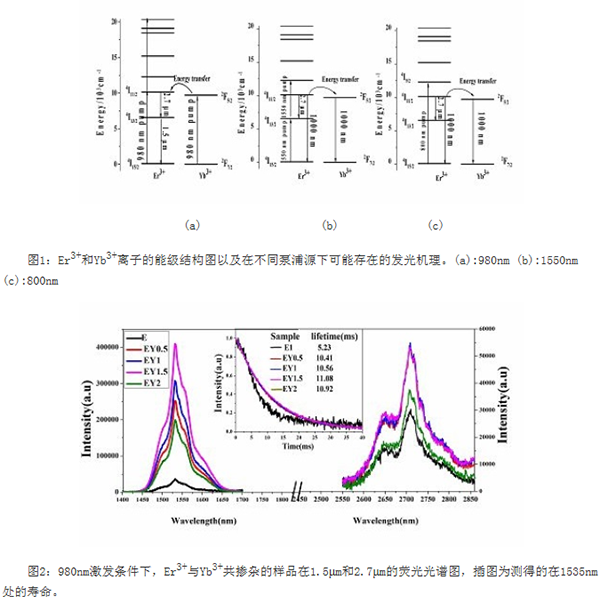
Rare earth doped laser glass materials have always been the focus of research in the field of optical materials. In recent years, 2-3 μm laser glass materials have important application prospects in fields such as medical treatment, optical communication, and environmental monitoring. The previous studies mainly focused on ZBLAN, a product glass fiber currently on the market, but its physical and mechanical properties were poor. In particular, there was less research on the development of new types of mid-infrared luminescent materials with good physicochemical properties and luminescent properties in China. . Researchers at the Shanghai Institute of Optics and Fine Mechanics, Chinese Academy of Sciences, for the first time studied the possibility of containing a small amount of yttrium oxide fluoroaluminate glass as a mid-infrared luminescent material. At the same time, the Er3+ and Yb3+ ions were doped under different pump sources. The luminescence mechanism is reported in Scientific Reports [Scientific Reports, 5, 8233, 2015].
The light-emitting Er3+ ion-doped fluoroantimonate glass component developed by researchers of Shanghai Optics-Machine Institute is mainly composed of a fluoroaluminate structure, which has advantages of low phonon energy, wide infrared transmission range, and the like. With a small amount of yttrium oxide adjustment, the glass forming performance was significantly improved compared to pure fluoride. The results show that Er3+-doped fluoroaluminum gallate glass is suitable as a mid-infrared luminescent material. Under the condition of 980 nm excitation, when Er3+ and Yb3+ are co-doped, Yb3+ can effectively absorb the pump light and pass through Yb3+:2F5/2. →Er3+:4I11/2 passes to Er3+ ions, increasing the infrared emission in the infrared region; at 1550 nm and 800 nm excitation conditions, Yb3+ acts as the acceptor ion, and Er3+ transfers energy to the Yb3+ ion through the reverse process, increasing its conversion and emission at 1 μm. This provides a new choice for mid-infrared luminescent materials.
Hydroxypropyl Methylcellulose is white or white powder, and in cold water is dissolved into clarified or cloudy colloidal solution. Aqueous solution has surface activity, high transparency and stable performance. HPMC has the properties of hot gels. The product water solution is heated and the gel is dissolved, then dissolved and the gel temperature of different specifications is different. The solubility changes with the viscosity, the lower the viscosity, the greater the solubility, and the different specifications of HPMC have certain differences
Application:
The hydroxypropyl methylcellulose can be used as the water protection agent and retarder of cement mortar, so that the mortar can be pumped.
In the mortar, gypsum, putty powder or other building materials as adhesives, improve the application and prolong the operation time.
Use as paste ceramic tile, marble, plastic adornment, paste enhancement agent, still can reduce cement dosage.
The water retention performance of HPMC will prevent the slurry from cracking after the application and strengthen the strength after hardening.
The molecular formula of hydroxypropyl methylcellulose is shown below

Hydroxypropyl Methyl Cellulose has high viscosity, medium viscosity, low viscosity, and has a viscosity of 50000, 100000,150000, 200000.
If you have any questions, please contact with us directly. Sincere cooperation, product quality and stability, advanced technology. Welcome you can visit our Factory.For inqury,Please send mail directly to us

Hydroxypropyl Methylcellulose
Hydroxypropyl Methylcellulose,Hpmc Pharmaceutical Grade,Mhpc Hydroxypropyl Methylcellulose,Hmpch Ydroxypropyl Methylcellulose
Hebei pancan trading co. LTD , https://www.hbpancanshangmao.com